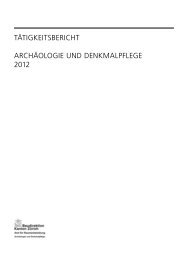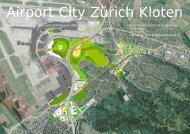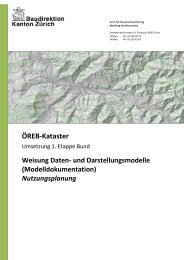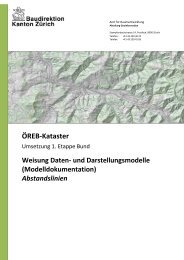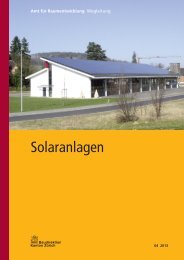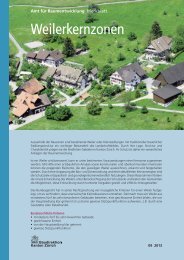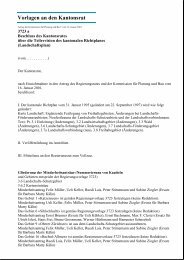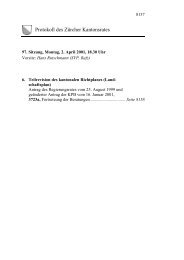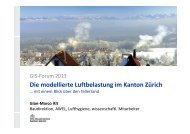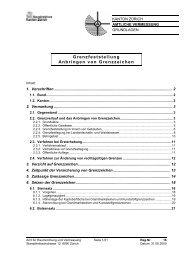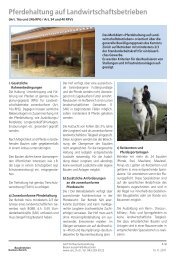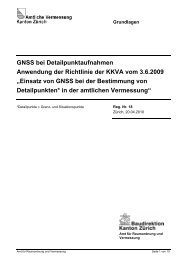Settlement Development in the Canton of Zurich
Settlement Development in the Canton of Zurich
Settlement Development in the Canton of Zurich
You also want an ePaper? Increase the reach of your titles
YUMPU automatically turns print PDFs into web optimized ePapers that Google loves.
«Regional Centres» as a Model<br />
for <strong>Settlement</strong> Structure<br />
16 Years after <strong>the</strong> commitment to undertake<br />
regional plann<strong>in</strong>g work <strong>in</strong> <strong>the</strong> <strong>Canton</strong><br />
<strong>of</strong> <strong>Zurich</strong> <strong>the</strong> revision to <strong>the</strong> Build<strong>in</strong>g Law<br />
<strong>of</strong> 1959 allowed <strong>the</strong> effective del<strong>in</strong>eation<br />
<strong>of</strong> built and open areas.<br />
The number <strong>of</strong> Communities with a Build<strong>in</strong>g and Zon<strong>in</strong>g<br />
Ord<strong>in</strong>ance (BZO) <strong>the</strong>n <strong>in</strong>creased steadily (by 1974 only<br />
Sternenberg and Kyburg were without a BZO). At <strong>the</strong><br />
same time <strong>the</strong> «decentralisation with def<strong>in</strong>ed centres»,<br />
as <strong>the</strong> model <strong>of</strong> «regional centres», had yet to be established<br />
<strong>in</strong> spatial plann<strong>in</strong>g.<br />
Some Comprehensive Plans were set <strong>in</strong> «tablets <strong>of</strong><br />
stone» by <strong>in</strong>corporat<strong>in</strong>g general build<strong>in</strong>g studies:<br />
The «Oberland Town» (1968), which <strong>in</strong>cluded five<br />
autonomous Communities, had as its ma<strong>in</strong> focus<br />
Wetzikon and H<strong>in</strong>wil. Follow<strong>in</strong>g <strong>the</strong> concept <strong>of</strong> <strong>the</strong><br />
Anglo-Saxon derived spatial idea <strong>of</strong> «Garden Cities»<br />
<strong>the</strong> development would ma<strong>in</strong>ta<strong>in</strong> and preserve <strong>the</strong><br />
landscape by <strong>the</strong> careful design <strong>of</strong> <strong>the</strong> built areas.<br />
Through different architectural styles <strong>the</strong> negative<br />
impacts <strong>of</strong> urbanization would be avoided, by firmly<br />
establish<strong>in</strong>g <strong>the</strong> creation <strong>of</strong> open areas, generous spaces<br />
and important recreation grounds <strong>in</strong> <strong>the</strong> immediate<br />
vic<strong>in</strong>ity <strong>of</strong> <strong>the</strong> urban area. Also, by allow<strong>in</strong>g for <strong>the</strong><br />
eventual quadrupl<strong>in</strong>g <strong>of</strong> <strong>the</strong> resident population, on <strong>the</strong><br />
basis that it would ultimately be 100,000 residents, it<br />
was seen as be<strong>in</strong>g feasible to guarantee that <strong>the</strong> town<br />
would <strong>of</strong>fer high quality hous<strong>in</strong>g.<br />
The study «A New Town <strong>in</strong> <strong>the</strong> Furt Valley» (1965) envisaged<br />
urban development <strong>in</strong> <strong>the</strong> area <strong>of</strong> Otelf<strong>in</strong>gen. High<br />
rise, l<strong>in</strong>ear residential build<strong>in</strong>g forms with large <strong>in</strong>terspersed<br />
open spaces would dom<strong>in</strong>ate <strong>the</strong> landscape.<br />
Here <strong>in</strong>dividual mobility had precedence; reference to a<br />
public transport centre did not appear <strong>in</strong> <strong>the</strong> language.<br />
The planned street pattern was tailored for 30,000 residents,<br />
each rely<strong>in</strong>g upon personal transport, and as such<br />
would have provided a modern form for a volume <strong>of</strong><br />
traffic that would not be necessary even today.<br />
«Oberland Town» <strong>in</strong> <strong>the</strong> area <strong>of</strong> Wetzikon–H<strong>in</strong>wil (1968).<br />
The layout <strong>of</strong> <strong>the</strong> «Furt Valley Town» was characteristic<br />
<strong>of</strong> <strong>the</strong> spirit <strong>of</strong> optimism that prevailed at that time.<br />
After <strong>the</strong> publish<strong>in</strong>g <strong>of</strong> <strong>the</strong> report by <strong>the</strong> Club <strong>of</strong> Rome<br />
entitled «The Limits to Growth» <strong>in</strong> 1972 and <strong>the</strong> oil crisis<br />
<strong>of</strong> 1973, which at <strong>the</strong> same time ended <strong>the</strong> longest<br />
known phase <strong>of</strong> economic growth, ecological problems<br />
came to <strong>the</strong> fore. In <strong>the</strong> consciousness <strong>of</strong> <strong>the</strong> wider<br />
population <strong>the</strong> «quality <strong>of</strong> life» became a key concept.<br />
The spatial development <strong>of</strong> <strong>the</strong> <strong>Canton</strong> <strong>of</strong> <strong>Zurich</strong> <strong>in</strong> <strong>the</strong><br />
1950s and 1960s was greatly <strong>in</strong>fluenced by <strong>the</strong> impact<br />
<strong>of</strong> traffic. Such was <strong>the</strong> strength <strong>of</strong> this <strong>in</strong>fluence that<br />
traffic itself could be regarded as an important «town<br />
and country planner». At <strong>the</strong> beg<strong>in</strong>n<strong>in</strong>g <strong>of</strong> <strong>the</strong> 20th Century<br />
it had been <strong>the</strong> railway which had contributed<br />
much to <strong>the</strong> def<strong>in</strong>ition <strong>of</strong> <strong>the</strong> urban hierarchy, but after<br />
<strong>the</strong> Second World War it was <strong>the</strong> enhanced mobility<br />
afforded by private vehicles that symbolised freedom<br />
«Furt Valley Town» <strong>in</strong> <strong>the</strong><br />
area <strong>of</strong> Otelf<strong>in</strong>gen (1965).<br />
and <strong>the</strong> modern way <strong>of</strong> life. In 1958 population<br />
approved a referendum on <strong>the</strong> issue <strong>of</strong> <strong>the</strong> Swiss<br />
national road network.<br />
Noteworthy at this time, from <strong>the</strong> regional perspective,<br />
is <strong>the</strong> promotion <strong>of</strong> a national road network, <strong>in</strong> <strong>Zurich</strong><br />
this was reflected <strong>in</strong> an express highway «Y» to crosscity<br />
residential quarters. It was envisaged this proposed<br />
Through Traffic <strong>in</strong> <strong>the</strong> City <strong>of</strong> <strong>Zurich</strong> on 11 July 1956 (Illustration<br />
City <strong>of</strong> <strong>Zurich</strong> Department <strong>of</strong> Civil Eng<strong>in</strong>eer<strong>in</strong>g).<br />
traffic management scheme would carry <strong>the</strong> dom<strong>in</strong>ant<br />
share <strong>of</strong> <strong>the</strong> traffic orig<strong>in</strong>at<strong>in</strong>g <strong>in</strong> and with dest<strong>in</strong>ations<br />
<strong>in</strong> those l<strong>in</strong>ked parts <strong>of</strong> <strong>the</strong> city. It was justified on <strong>the</strong><br />
unimportant scale <strong>of</strong> through traffic. To this day <strong>the</strong> city<br />
express highway has only partially been realised.<br />
6



